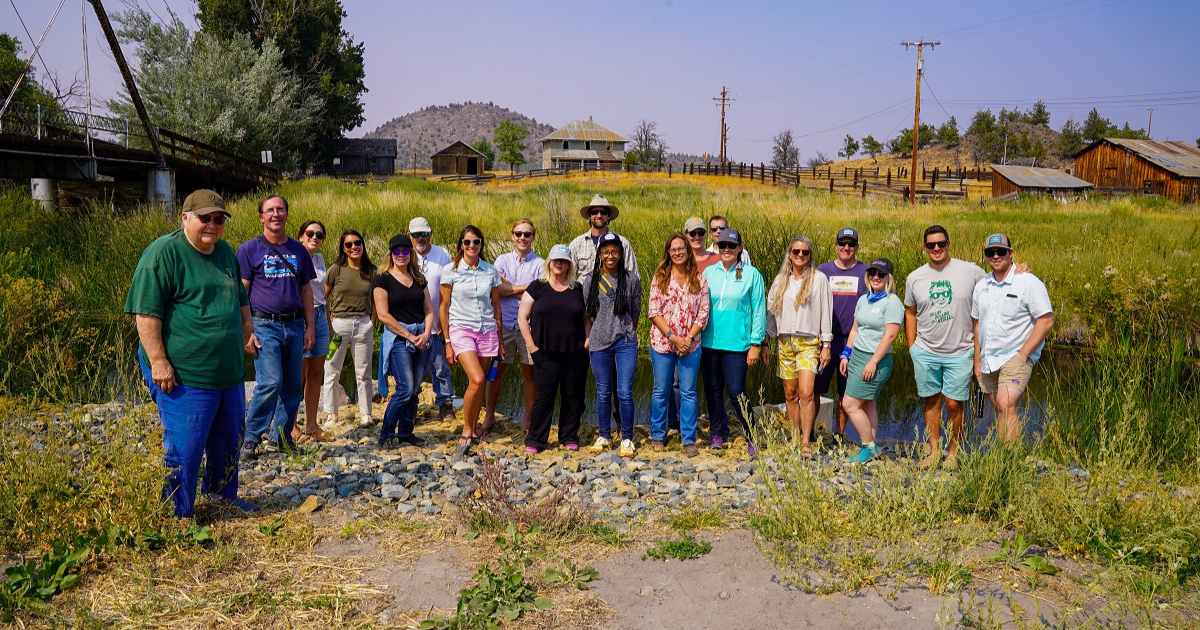Field Notes: CalTrout’s Staff Retreat
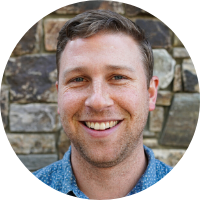 By Patrick Samuel, Bay Area Regional Director
By Patrick Samuel, Bay Area Regional Director
Members of the growing CalTrout team were recently able to safely meet up for a long-overdue staff retreat in beautiful Mount Shasta. Each of our 6 regional offices was represented, with many of us heading to Shasta for the first time. We spent three days visiting project sites, sharing stories at Trout Camp (including touring the beautiful new “Bobby Mayfly” cabin graciously donated by the Hellman Family), and enjoying face-to-face meetings for the first time in a long while discussions among staff built upon our excitement surrounding CalTrout’s new 3-year strategic plan and the work to follow.
The hot afternoon sun met our shoulders on the front porch of the Shasta office. First round of business was to share negative COVID test results and distribute rapid tests for good measure. After reiterating safety protocols for travel, meetings, and lodging, we headed north to the Cardoza on-farm efficiency project. Frank and Jeannie Cardoza met us at their property surrounding Parks Creek and the Shasta River and we learned how local landowners work with CalTrout to improve efficiency on their farms while creating successful environmental conditions for coho salmon and steelhead. Viewing the scale and technical expertise needed to pull off such a large project while also meeting the property owners that support our projects was awe-inspiring. The Shasta River has always been an important contributor of fish in the Klamath watershed, and its importance will only continue to grow once the Klamath River dams come down.
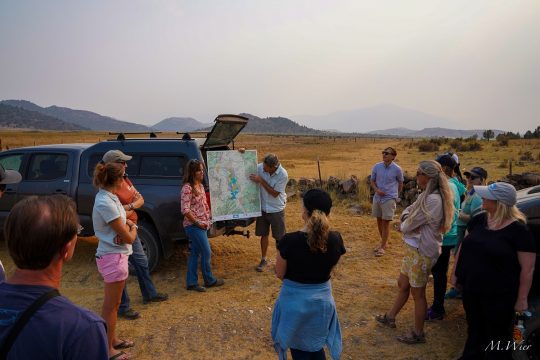
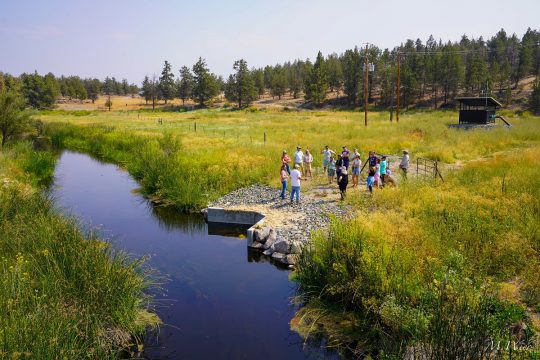
Invigorated by our tour, staff headed to the back deck of a Shasta home to enjoy fantastic cooking from Ryan (hey, Bristol Catering!) and partake in competitive cornhole games on the lawn. We were also able to wish our dear friend and longtime CalTrout Mt. Shasta Director, Drew Braugh, farewell in person. Drew is one of the first CalTrout staff to build regional efforts for CalTrout; his leadership, passion, dedication, and mentorship will be sorely missed. A rousing game of “favorite movie” left us all to part ways and dream of fish swimming freely in our minds.
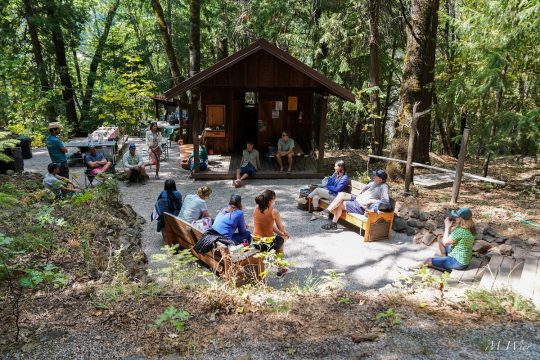
Cool air flowing through a smoke-less valley welcomed us to our second day of staff retreat. After a round of hot coffees and homemade breakfast on the back deck, we got to work. Detailed team discussions tying our key initiatives from region to region allowed us to share experiences, recap projects, and learn from one another. A major theme, communication and clarification, was the lead attribute to how well our team works together and how success follows. And while Zoom has been a helpful way for us all to keep in touch, it was so refreshing to brainstorm in person. We developed standard metrics that will enable us to better share our stories with members like you. These metrics will deliver clear benchmarks and progress in our work – a challenging but necessary communication tool in our world of complex partnerships, agency bureaucracy, and the shifting winds of political and grant-making priorities.
Productive morning sessions ended with bagged lunches and stretched legs and lungs as we headed to Shasta Springs. This CalTrout property on the Cantara Loop on the Upper Sacramento River brings together staff, board members, and Golden Trout Circle members as if it were their own family escape. Indeed, heading down to Mossbrae Falls felt like a summer family trip. As we strolled down the railroad tracks to the breathtaking falls, it was unfathomable to see the amount of cold, clean water running out of Shasta Springs. We ate our lunches in the midday sun, cooled by the refrigerator-like effect of spring water swelling the Upper Sacramento River. CalTrout’s Field Reporter, Mike Wier was able to take new headshots of us for the website as well. Revitalized, we sauntered back to Trout Camp.
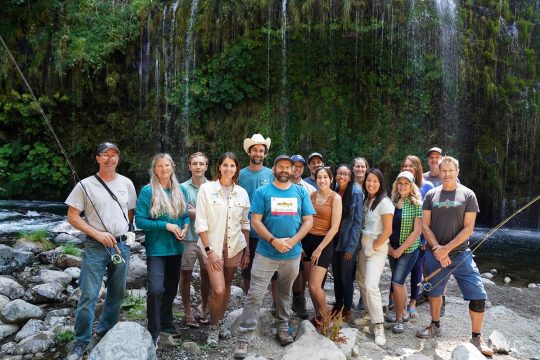
Our final stop that afternoon was to clamber onto a houseboat on Lake Siskiyou for an afternoon of solace, taking in views of Mount Shasta, Mount Eddy, and Castle Crags. Tracey Diaz, gamemaster extraordinaire (and CalTrout’s Development and Communications Director), led us in rounds of “first concert, best concert”, capping off a perfect cruise around the lake.
The last evening of any get-together usually runs long, and so did ours as we were reminded that this would be the last time we’ll be together as a group for a while. It led to a quieter “last” morning with more focus involving team discussions on drought in California and the impacts on California’s fish, future funding opportunities focused on drought and climate change, and ways to continue to be at the forefront of California’s conservation work. We discussed how to best use our growing legal and policy team in Sacramento to cement relationships with legislators and agencies, and steer future funding toward science-based, multi-benefit projects like the ones we are implementing statewide. The growing facets of our team can be leveraged to work bigger, faster, and better to ensure healthy waters and resilient wild fish for a better California.
Our time together ended with a location poll on next year’s staff retreat (location to be announced at a later time) and a potential for a staff float trip down the Klamath River below Iron Gate Dam given the timeliness of construction beginning in 2023.
We wrapped up the retreat and said our goodbyes, with some of the crew heading home and others opting to stay another night. Those of us who had to leave took our rapid covid-19 tests and bid one another farewell for now, but not for long. Fishing was in the cards for the few of us that stayed. With that we capped off our first successful in-person team meeting in over a year. Reenergized, we look forward to taking on the challenges of this 51st year for CalTrout and making it our best one yet.
We can’t wait to see the full team together again on September 24th for CalTrout’s 50th Anniversary Expo and celebration in San Francisco.
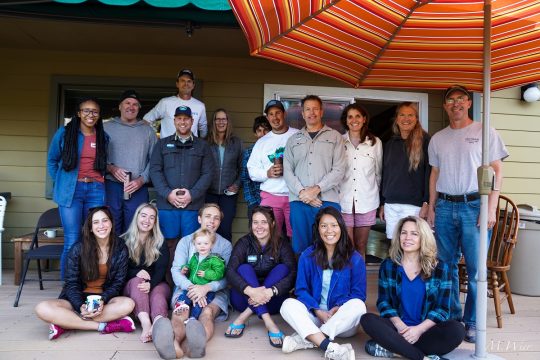
To inquire about Trout Camp availabilities and booking, join the Golden Trout Circle and connect with Ash of the CalTrout team.
In the fish world, fantastic caterers are held close. We are thankful to know Ryan of Bristol Catering & Events, who has two young smolts of his own that we were lucky to meet this September.


